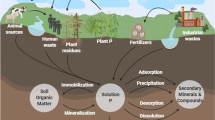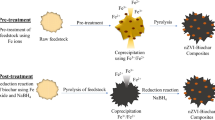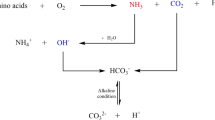Abstract
The removal of fluoride from environmental surface water and groundwater is an important environmental issue in Tunisia. Notably, Tunisia also faces a shortfall in reservoir capacity due to the buildup of sediment containing calcium carbonate. Dicalcium phosphate dihydrate (DCPD, CaHPO4·2H2O) reacts effectively with fluoride to form stable fluorapatite (FAp, Ca10(PO4)6F2), and the addition of calcium carbonate (CaCO3) effectively inhibits the release of phosphate generated during this reaction. In this study, we tested the potential for fluoride removal using a mixture of DCPD and Tunisian reservoir sediment. The release of phosphate from the reaction of DCPD with fluoride was successfully inhibited using the sediment. The application of the DCPD–sediment mixture led to a high rate of fluoride removal (15–19 mg/g), such that the resulting water met the World Health Organization (WHO) recommended limit for fluoride in water (1.5 mg/L). This removal rate is five to ten times those achieved with conventional fluoride adsorbents such as bone char. Based on these results, the utilization of Tunisian reservoir sediment seems to be an effective solution for removing fluoride from aqueous environments.








Similar content being viewed by others
References
Chow LC, Brown WE (1973) Reaction of dicalcium phosphate dihydrate with fluoride. J Dent Res 52:1220–1227
Drouichea N, Ghaffourb N, Lounicic H, Mameric N, Maallemia A, Mahmoudid H (2008) Electrochemical treatment of chemical mechanical polishing wastewater: removal of fluoride—sludge characteristics—operating cost. Desalination 223:134–142
Duff EJ (1970) Orthophosphates—I. Formation of apatites from calcium phosphates in potassium fluoride solutions. J Inorg Nucl Chem 32:3707–3708
Fawell J, Bailey K, Chilton J, Dahi E, Fewtrell L, Magara Y (2006) Fluoride in drinking water. IWA, London
Fuji M, Tsuchimoto J, Takai C, Goto R, Irie M, Tarhouni J (2017) Adaptability of sediment from Joumine reservoir, Tunisia, as a ceramic raw material. Euro-Mediterr J Environ Integr 2:26
Ganvir V, Das K (2011) Removal of fluoride from drinking water using aluminum hydroxide coated rice husk ash. J Hazard Mater 185:1287–1294
Guissouma W, Tarhouni J (2015) Fluoride in Tunisian drinking tap water. J Water Res Prot 7:860–870
Irie M (2017) Sedimentation in water reservoirs in arid region. J Arid Land Stud 27(1):25–31
Irie M, Han J, Kawachi A, Tarhouni J, Ksibi M, Kashiwagi M, Isoda H (2014) In vitro testing and commercialization potential of extracted fulvic acid from dredged sediment from arid region reservoirs. Waste Biomass Valor 5(2):273–281
Kawai T, Ohtsuki C, Kamitakahara M, Tanimura M, Miyazaki T, Sakaguchi Y, Konagaya S (2006) Removal of formaldehyde by hydroxyapatite layer biomimetically deposited on polyamide film. Environ Sci Technol 40:4281–4285
Maatouk F, Jmour B, Ghedira K, Argoubi K, Abid A (1998) Dental fluorosis in Kairouan, Tunisia. Dent News 5(1):17–19
Manzora AS, Laouali MS, Ben Amor M (2015) A comparative study of the defluoridation efficiency of synthetic dicalcium phosphate dihydrate (DCPD) and lacunar hydroxyapatite (L-HAp): an application on synthetic solution and Koundoumawa field water. Afr J Environ Sci Technol 9(2):111–125
Matsuoka M, Koizumi M, Maeda I (2012) Fertilizer and method for producting same. Patent WO2012/13524 A1
Medellin-Castillo NA, Leyva-Ramos R, Ocampo-Perez R, Garcia de la Cruz R, Aragon-Pina A, Martinez-Rosales J, Guerrero-Coronado R, Fuentes-Rubio L (2007) Adsorption of fluoride from water solution on bone char. Ind Eng Chem Res 46:9205–9212
Medellin-Castillo N, Leyva-Ramos R, Padilla-Ortega E, Ocampo Perez R, Flores-Cano JV, Berber-Mendoza MS (2014) Adsorption capacity of bone char for removing fluoride from water solution. Role of hydroxyapatite content, adsorption mechanism and competing anions. J Ind Eng Chem 20:4014–4021
Mohapatra M, Anand S, Mishra BK, Giles DE, Singh P (2009) Review of fluoride removal from drinking water. J Environ Manag 91:67–77
Nishida H, Kimata M, Ogata T, Kawai T (2017) Malodors adsorption behavior of metal cation incorporated hydroxyapatite. J Environ Chem Eng 5:2815–2819
Sternitzke V, Kaegi R, Audinot J-N, Lewin E, Hering JG, Johnson CA (2012) Uptake of fluoride from aqueous solution on nano-sized hydroxyapatite: examination of a fluoridated surface layer. Environ Sci Technol 46:802–809
Suzuki K (2007) Raw Materials, Production, and the Properties of Gelatin. J Soc Photograph Sci Technol Jpn 67:379–385. https://doi.org/10.11454/photogrst1964.67.379
Tafu M, Chohji T (2005) Reaction of calcium hydrogenphosphate dihydrate (DCPD) with a solution containing a small amount of fluoride. J Ceram Soc Jpn 113:363–367
Tafu M, Chohji T (2006) Reaction between calcium phosphate and fluoride in phosphogypsum. J Eur Ceram Soc 26:767–770
Tafu M, Manaka A (2015) Immobilization of fluoride and heavy-metals in polluted soil. In: Hasegawa H, Rahman IMM, Rahman MA (eds) Environmental remediation technologies for metal-contaminated soils. Springer, Tokyo, pp 147–159
Tafu M, Chohji T, Morioka I, Hiwasa M, Nakano H, Fujita T (2010) Stabilization of fluoride in waste gypsum by using surface-modified calcium phosphate particle. Trans Mater Res Soc Jpn 35:377–380
Tafu M, Arioka Y, Takamatsu S, Toshima T (2016) Properties of sludge generated by the treatment of fluoride-containing wastewater with dicalcium phosphate dihydrate. Euro Mediterr J Environ Integr 1:4
Tafu M, Muroyama S, Takamatsu S, Toshima T, Chohji T, Matsushita Y, Fujita T (2017) Controlling phosphate release from treatment of fluoride in wastewater by using dicalcium phosphate dihydrate (DCPD). J Environ Saf 8(1):23–29
Walha K, Ben Amar R, Firdaous L, Quemeneur F, Jaouen P (2007) Brackish groundwater treatment by nano-filtration, reverse osmosis and electrodialysis in Tunisia: performance and cost comparison. Desalination 207:95–106
Acknowledgements
The authors appreciate the support of Nitta Gelatin Inc. (Osaka, Japan) in terms of providing DCPD samples. We thank Guy Evans, PhD, from Edanz Group (http://www.edanzediting.com/ac) for editing a draft of this manuscript, and Mr. Fuyu Ninomiya, National Institute of Technology, Toyama College for supporting the experiments described in this article.
Funding
This research was partially funded by a Grant-in-Aid for Scientific Research (C) (grant number 17K00631) from the Japan Society for the Promotion of Science, Japan.
Author information
Authors and Affiliations
Corresponding author
Ethics declarations
Conflict of interest
All of the authors have declared no conflicts of interest.
Additional information
Communicated by Chedly Tizaoui, Associate Editor.
Rights and permissions
About this article
Cite this article
Tafu, M., Sasakawa, N., Murthy, H.S. et al. Effective removal of fluoride and phosphate pollution using mixtures of dicalcium phosphate dihydrate (DCPD) and Tunisian reservoir sediment containing calcium carbonate. Euro-Mediterr J Environ Integr 5, 1 (2020). https://doi.org/10.1007/s41207-019-0135-8
Received:
Accepted:
Published:
DOI: https://doi.org/10.1007/s41207-019-0135-8




